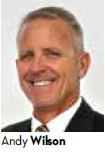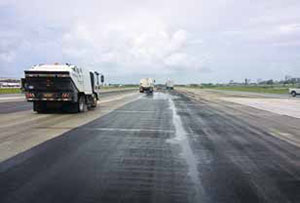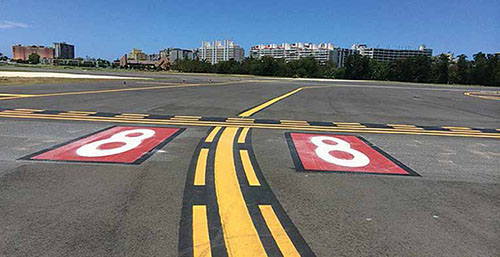Private Operator Looks Airside at San Juan Int'l
 When Aerostar Airport Holdings took over the day-to-day operation of Luis Munoz Marin International Airport (SJU) in San Juan, Puerto Rico, it also assumed responsibility for several in-process and future projects, including airfield infrastructure upgrades. These projects, combined with other planned improvements, are expected to complement the private operator's goals for continued growth at the northeastern Caribbean airport.
When Aerostar Airport Holdings took over the day-to-day operation of Luis Munoz Marin International Airport (SJU) in San Juan, Puerto Rico, it also assumed responsibility for several in-process and future projects, including airfield infrastructure upgrades. These projects, combined with other planned improvements, are expected to complement the private operator's goals for continued growth at the northeastern Caribbean airport.
Aerostar is a joint venture between Highstar Capital and Aeropuertos del Sureste that signed a 40-year lease agreement in July 2012 with the Puerto Rico Ports Authority. Aerostar received its operator certificate from the FAA in February 2013 and is part of the administration's Privatization Pilot Program.
Assuming control and payment from the Puerto Rico Ports Authority (PRPA) for airfield jobs already underway was a challenge, notes Andy Wilson, Aerostar's chief development officer. "Synchronizing the accounting process between the FAA, PRPA and Aerostar had never been accomplished before, and the learning curve was steep for all parties," he says.
 factsfigures factsfiguresProjects: Airfield Improvements & Maintenance Location: Luis Munoz Marin Int'l Airport (San Juan, Puerto Rico) Private Operator: Aerostar Airport Holdings Operations Safety Aesthetics Contract: Hi-Lite Airfield Services Pavement Management Study: AVCON Other Airfield Project Consultants: CHM2Hill; Kimley-Horn |
With the transfer of sponsorship complete, the private operator has a "fair amount of catch-up" to accomplish on the airfield, reports Wilson. While some of the work is related to the age or deterioration level of existing pavements, other stems from prior maintenance practices. "Most of the pavements on the airfield are in need of some sort of improvement," he relates.
Among the mid-stream projects Aerostar assumed is a runway safety area initiative on SJU's longest runway, 8-26. By extending the runway 400 feet to the west and relocating the east end of the runway, planners created room for a standard 1,000-foot safety area for the entire runway. Improvements were funded by a $22.6 million FAA grant and completed in mid-2013.
A taxiway repaving project also concluded after the transfer. That taxiway has since failed and is now closed, reports Ismael Bonilla, Aerostar's chief operating officer. "FAA, in conjunction with Aerostar, has hired a forensics pavement engineer to look at existing conditions of pavement on the airfield," Wilson states. AVCON contracted Robert Boyer, Ph.D., to perform the analysis; results of the studies are pending.
Other airfield improvements at SJU include navigational aid upgrades, such as the installation of FAA's Medium-Intensity Approach Lighting System with Runway Alignment Indicator Lights (MALSR). Another project addressing tree encroachment into the runway object-free area has been put on hold because of a disagreement regarding the removal of trees between the Army Corps of Engineers and FAA. A project to study the runway object-free area and airfield drainage, however, was recently approved for Airport Improvement Program funding.

Roughly 400 trees have already been removed near Runway 8-26 because they were impacting the instrument landing system glideslope signal. With that project complete, SJU has two fully functional instrument landing systems for the first time since the mid '90s, notes Bonilla. Prior to that, the airport experienced a lot of downgrades and restrictions because of obstructions and interferences,
Wilson adds.
"We're investing heavily in this project," Bonilla says of Aerostar's commitment to airfield improvements.
Maintaining Pavements
Bonilla characterizes Aerostar's airfield maintenance program as "very aggressive." Last year, he notes, SJU spent more than $1 million repainting Runway 10-28 because of previous improper care. About $150,000 is spent monthly to maintain runways, taxiways and ramps.

"We have professional project administration capabilities that we bring to the table," he states. "And with our experience in operating airports, we'll make sure that we maintain those runways and taxiways."
Bonilla characterizes Aerostar's maintenance and repair strategy as holistic and proactive. "We try to take care of any smaller issues with the asphalt or concrete before it becomes a major issue," he explains.
Recent equipment investments at SJU include two FOD Bosses and the $50,000 restoration of a sweeper owned by the ports authority.
To supplement the airport's in-house maintenance program, Aerostar contracted Hi-Lite Airfield Services to manage the friction on SJU's runways. Per a five-year agreement, Hi-Lite performs weekly friction tests and visual inspections; rubber removal is executed as needed. Hi-Lite is also responsible for pilot visibility, including all airfield markings.
"We do monthly and quarterly inspections, and we're continuously out there cleaning, painting, and whatever needs to be done to keep markings fully compliant and be prepared to pass a Part 139 inspection at any time," says Calvin McNeely, the company's executive vice president. "We're being proactive instead of reactive."

Prior to signing the current contract with Hi-Lite, Aerostar hired the contractor to help prepare for the original Part 139 inspection at SJU.
Bonilla considers the contract with Hi-Lite "significant" for Aerostar. "Those guys are boots on the ground," he explains. "They have people stationed here dealing with maintaining the runways, cleaning them, cleaning taxiways, repainting everything. That way, when the inspection comes next year, we don't have to scramble at the last minute to try to make sure everything is taken care of."
The contract also saves SJU money in the long run, he adds. The cost to buy and maintain a friction analyzer alone (something required by Aerostar's contract with the Puerto Rico Ports Authority) is prohibitive, he explains.
Future Enhancements
As Aerostar continues to upgrade and maintain SJU's airfield, managing aircraft circulation around the terminal complex has emerged as most important issue, Wilson reports.
Taxiway N, the airport's main north-south connector between the runways, is programmed to receive an FAA grant for repairs in 2015. Other plans call for a $14 million full overlay and connector reconstruction of Runway 8-26 and Taxiway S in spring 2015. Runway 8-26, which hasn't been repaved for 15 to 20 years, is also due for a facelift and joint sealing repairs, Bonilla notes.

Currently, Aerostar is in the process of completing an airport pavement management study with AVCON - a process that will provide near-term, mid-term and long-term capital improvement plans (and budget figures) for pavement restoration, repair and replacement. "It's a very extensive program," says Wilson. In addition, geotechnical investigations will help document pavement sections that lack record drawings.
Air cargo is a market segment Aerostar has identified as a promising revenue source. But the airport's existing facilities will need to be developed to realize that potential, Wilson notes. "Within the next 24 to 30 months, we'd like to have some significant [cargo area] improvements in place," he relates.
FedEx and UPS currently operate out of SJU, and CargoLux recently announced its return to the airport. In 2012, SJU moved about 850 million pounds of cargo, ranking 25th out of 112 U.S. cargo airports.

FREE Whitepaper
Fairbanks International Airport Baggage Transport Conveyor Enhanced With Mod Drive™ System
Airports face a host of unique industry challenges, such as meeting efficiency regulations and seeking out the best maintenance practices to reduce costs and keep operations flowing. In today’s current economic climate, any potential cost savings can go a long way.
In 2019, Alaska’s Fairbanks International Airport (FAI) sought to modernize its equipment and operations. They were dissatisfied with the performance of the gearmotors on their baggage transport conveyors and began searching for new suppliers. Regal approached FAI with a solution that could improve equipment performance and simplify maintenance, with the added benefit of energy cost savings: the Hub City® MOD Drive™ system.
This white paper discusses the hardware deployed, the test results and the annualized expectations for ROI.








